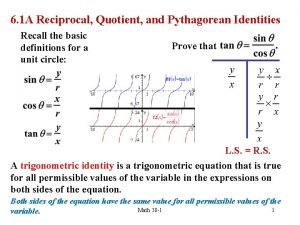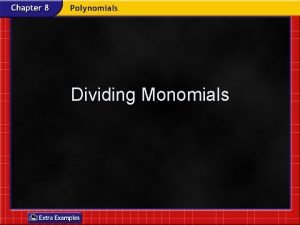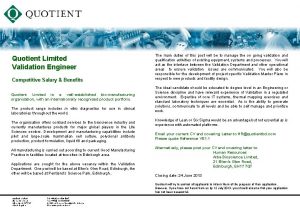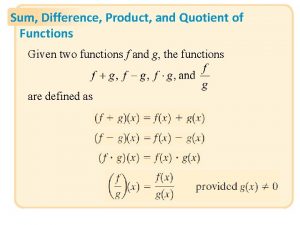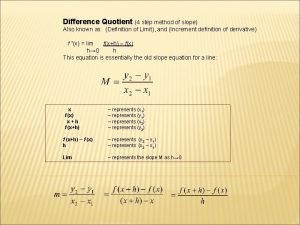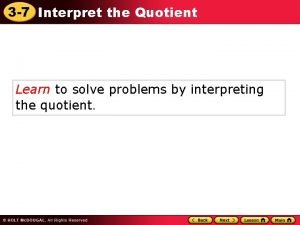The Difference Quotient What is the Difference Quotient
















- Slides: 16

The Difference Quotient

What is the Difference Quotient? Consider a function f(x). Let P be an any point (x, f(x)) on the function f(x), h be a non-zero real number, and Q be the point (x+h, f(x+h)). Q P (x, f(x)) y = f(x) (x+h, f(x+h))


Using the Difference Quotient A Linear Function f(x) = 2 x + 6 Substitute x+h for x in f(x) and subtract f(x). Divide by h. Distribute to clear parentheses. Combine like terms. Simplify the fraction. = 2.

A Quadratic Function • Substitute x+h for x in f(x) and subtract f(x). Divide by h. FOIL to simplify and distribute to clear parentheses. Distribute to clear remaining parentheses. Combine like terms. Factor numerator. Simplify the fraction.

A Square Root Function • Substitute x+h for x in f(x) and subtract f(x). Divide by h. Distribute to clear parenthesis. Combine like terms. Multiply numerator and denominator by the conjugate (the sum’s same terms, but with a flipped sign: i. e. addition to subtraction, or subtraction to addition) of the numerator. Multiply to simplify. Use difference of two squares formula (a+b)(a-b) = a 2 – b 2. Leave denominator in factored form. Simplify. Combine like terms. Simplify the fraction.

A Cubic Function f(x) = x 3 Substitute x+h for x in f(x) and subtract f(x). Divide by h. Simplify. Combine like terms. Factor numerator. Simplify the fraction. = 3 x 2 + 3 xh+ h 2.

Instantaneous Rate of Change The Derivative •

Finding the Derivative: A Reexamination of Previous Examples

f(x) = 2 x+6 (Linear Function) Use the definition of a derivative, (slide #8). Substitute the difference quotient evaluated on slide #4. To evaluate the limit, substitute 0 for every h in the expression. Since there is no h, the expression remains unchanged. In other words, the limit of a constant is the constant. = 2.

Use the definition of a derivative from slide #8. Substitute the difference quotient evaluated on slide #5. Substitute zero for h to evaluate the limit. Simplify.

Use the definition of a derivative. Substitute the difference quotient evaluated on slide #6. Substitute zero for h to evaluate the limit. Combine like terms to simplify.

Use the definition of a derivative. Substitute the difference quotient evaluated on slide #7. Substitute zero for h to evaluate limit. Simplify.

Practice problems •

Answers •

Wylie Campus Wylie. APCAA@collin. edu https: //wylie. mywconline. com Online & On Campus appointments seven days per week. Math, Sciences, Writing, Reading, Private Study Rooms, Printing, Computer Lab, Science Models
 Quotient reciprocal and pythagorean identities
Quotient reciprocal and pythagorean identities Symmetric difference quotient
Symmetric difference quotient Hát kết hợp bộ gõ cơ thể
Hát kết hợp bộ gõ cơ thể Bổ thể
Bổ thể Tỉ lệ cơ thể trẻ em
Tỉ lệ cơ thể trẻ em Gấu đi như thế nào
Gấu đi như thế nào Thang điểm glasgow
Thang điểm glasgow Hát lên người ơi
Hát lên người ơi Các môn thể thao bắt đầu bằng tiếng đua
Các môn thể thao bắt đầu bằng tiếng đua Thế nào là hệ số cao nhất
Thế nào là hệ số cao nhất Các châu lục và đại dương trên thế giới
Các châu lục và đại dương trên thế giới Công thức tính thế năng
Công thức tính thế năng Trời xanh đây là của chúng ta thể thơ
Trời xanh đây là của chúng ta thể thơ Cách giải mật thư tọa độ
Cách giải mật thư tọa độ 101012 bằng
101012 bằng độ dài liên kết
độ dài liên kết
